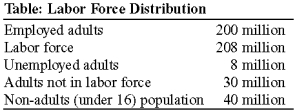A) 12.5%.
B) 20%.
C) 25%.
D) 50%.
Correct Answer

verified
Correct Answer
verified
Multiple Choice
Suppose that Allison has an accounting degree, but she lost her job two months ago when her company merged with another firm. Allison hasn't been able to find another accounting job, so she has taken a part-time job as a sales clerk at a clothing store. As a result the official unemployment rate will:
A) not change.
B) increase.
C) decrease.
D) increase temporarily, then fall back to its original level.
Correct Answer

verified
Correct Answer
verified
Multiple Choice
When the unemployment rate increased, the annual growth rate of real GDP has usually:
A) increased.
B) decreased.
C) not changed.
D) shown no relationship with changes in the unemployment rate.
Correct Answer

verified
Correct Answer
verified
Multiple Choice
If the U.S. dollar were replaced with a "new dollar" at an exchange rate of 1 new dollar for 8 old dollars, then a mortgage of $100,000 would become a debt of _____ new dollars.
A) 12,500
B) 99,992
C) 100,000
D) 800,000
Correct Answer

verified
Correct Answer
verified
True/False
If the price level at the end of year 1 is 150 and the price level at the end of year 2 is 160, the inflation rate in year 2 is 10%.
Correct Answer

verified
Correct Answer
verified
Multiple Choice
The natural rate of unemployment:
A) is composed of frictional, structural, and cyclical unemployment.
B) is equal to zero.
C) is always greater than the actual unemployment rate.
D) is composed of structural and frictional unemployment.
Correct Answer

verified
Correct Answer
verified
Multiple Choice
The unemployment rate is the ratio of all of the people:
A) out of work to the total population.
B) out of work to those over age 16.
C) unemployed to those looking for work.
D) unemployed to those in the labor force.
Correct Answer

verified
Correct Answer
verified
Multiple Choice
Discouraged workers:
A) are getting paid too little.
B) do not like their job.
C) are working part-time but are looking for a full-time job.
D) have given up looking for a job.
Correct Answer

verified
Correct Answer
verified
Multiple Choice
If a country has a working-age population of 200 million, 135 million people with jobs, and 15 million people unemployed and seeking employment, then its unemployment rate is:
A) 4%.
B) 7.5%.
C) 10%.
D) 67.5%.
Correct Answer

verified
Correct Answer
verified
Multiple Choice
Generous unemployment benefits are likely to cause:
A) an increase in the employment level.
B) a reduction in job search time.
C) a decrease in the unemployment rate.
D) an increase in the unemployment rate.
Correct Answer

verified
Correct Answer
verified
Multiple Choice
According to the Congressional Budget Office, the natural rate of unemployment:
A) has continually declined since 1950.
B) was at its lowest by the end of the 1970s.
C) has continually risen since 1950.
D) rose until the end of the 1970s and has declined since then.
Correct Answer

verified
Correct Answer
verified
True/False
The severe inflation in Israel during the mid-1980s was due to a war, an unstable government, and civil unrest in the country.
Correct Answer

verified
Correct Answer
verified
Multiple Choice
The unemployment rate is the:
A) percent of the labor force that is unemployed.
B) number of people unemployed.
C) the labor force minus the number of people unemployed.
D) average length of time someone is unemployed.
Correct Answer

verified
Correct Answer
verified
Multiple Choice
Use the following to answer questions  -(Table: Labor Force Distribution) Look at the table Labor Force Distribution. The total population is:
-(Table: Labor Force Distribution) Look at the table Labor Force Distribution. The total population is:
A) 486 million.
B) 253 million.
C) 278 million.
D) 283 million.
Correct Answer

verified
Correct Answer
verified
True/False
Both binding minimum wages and union wages may cause structural unemployment.
Correct Answer

verified
Correct Answer
verified
Multiple Choice
The natural rate of unemployment is:
A) the rate during recessions.
B) equal to the sum of frictional and cyclical unemployment.
C) equal to the sum of frictional and structural unemployment.
D) cyclical unemployment less frictional unemployment.
Correct Answer

verified
Correct Answer
verified
True/False
Real income is income divided by the price level.
Correct Answer

verified
Correct Answer
verified
True/False
The U.S. inflation rate was higher in the 2000s than it was in the 1970s.
Correct Answer

verified
Correct Answer
verified
Multiple Choice
Last month Brent lost his job at the auto parts factory because the factory relocated to Asia. Brent and his former coworkers have been looking for similar jobs, but they have found no openings. In Brent's town the _____ labor has _____.
A) supply of; fallen
B) supply of; risen
C) demand for; risen
D) demand for; fallen
Correct Answer

verified
Correct Answer
verified
Multiple Choice
Unemployment rates are usually highest for:
A) white teenagers.
B) African American teenagers.
C) male workers aged 25 to 54.
D) female workers aged 25 to 54.
Correct Answer

verified
Correct Answer
verified
Showing 261 - 280 of 351
Related Exams